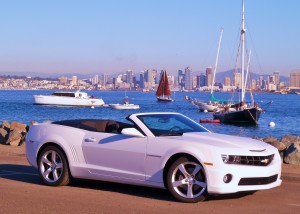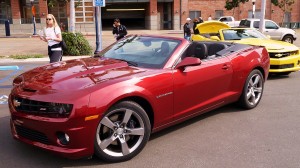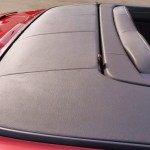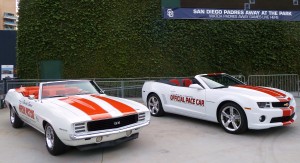Sky is the limit in new Camaro convertible
By John Gilbert
From the good ol’ high-performance days of the 1960s and ’70s, tradition has it that there are Chevy folks and there are Ford folks, and the twain isn’t likely to meet. It may be retro tradition, which would be appropriate, because the hottest history of the Chevy vs. Ford rivalry has been resurrected, 40 years later with the reborn Chevrolet Camaro taking on the never-left Ford Mustang.
The Mustang enjoyed a rejuvenation when the most recent styling changes took on the decided retro look of the 1970 model. Chevrolet spent a few years promoting that the discontinued Camaro would return, and when it finally came out, it was an enormous success. For the 2010 model year, Camaros outsold all versions of the Mustang, a fact that Chevrolet isn’t at all shy about trumpeting.
For 2011, the Camaro adds a model by going topless. A convertible model promises to cause another spike in sales for this year, and you can check the right boxes and wind up with a very impressive Chevrolet Camaro V6, or go all the way to the SS — Super Sport — convertible with a Corvette LS3 V8 and 426 horsepower.
Granted, there are others cars in the “ponycar” class besides the Mustang and Camaro. Dodge, for example, and Japanese, Korean, and German sports coupes and hot sedans fill the picture of contemporary performance cars. But none of that can detract from the new Camaro’s eye-popping success. When the Mustang first went retro, driving one on the street meant waves, horn honks and thumbs-up gestures from fellow-drivers and passengers, whether Ford, Chevy or anything else. The same happens with the new Camaro, and certainly with the Camaro convertible.
My first impression of the reborn Camaro coupe was that it felt very powerful, either with its big, 6.2-liter V8 or Chevy’s high-tech 3.6-liter V6, but it also felt very heavy, because it is, weighing in at 3,859 pounds curb weight. It is hefty enough that I had to ask Chevrolet officials why they’d build it tso heavy, then install various sophisticated suspension tricks to make it feel lighter and more agile? Wouldn’t it be wiser to simply build it lighter to begin with?
The answer lies in the resurrection. Costly as it has been to build the Camaro, General Motors was also fighting through a bankruptcy situation, so costs had to be controlled as much as possible. Chevrolet logically went to Holden, its Australian arm, because Australia is a hotbed of hot cars, as though it has been locked in its own time warp, where its wide-open spaces make the high-powered style of the U.S. in the late 1960s seem almost logical. It was Holden that built the late, and occasionally lamented, Pontiac GTO, and Pontiac’s similarly late G8 performance sedan.
Tom Peters, who grew up in the Minneapolis suburb of Deephaven, designed the new Camaro, using as a personal basis sketches he drew as a teenager of hot-rod versions of the 1969 Camaro. That pretty well assured the pleasing retro similarity of the all-new design. Production of the Camaro went to Australia, and Holden took over, taking the Pontiac G8, which is called the Holden Commodore in Australia, and creating the concept Camaro for several years-worth of auto shows. Naturally, coming from the heavy high-performance sedan, the Camaro is heavier than a smaller pony-car coupe needed to be. But it works.
The coupe, with its low roof and high beltline, limits outward visibility in for the sake of style, which may enhance the feeling of being heavy. The convertible, however, takes care of several of those issues. First of all, there’s no visibility better than putting the top down and having unlimited visibility. And while the convertible mechanism makes the car about 300 pounds heavier still — to 4,138 pounds — it feels lighter and sportier. Appearances can be deceiving. Performance is strong with either engine, which creates an interesting dilemma for buyers.
You can buy the 1LT model, for $29,150, which comes with the high-tech corporate 3.6-liter V6, with its dual overhead camshafts and direct injection, and a strong 312 horsepower. Spend a bit more, to a base of $33,500, and the 2LT adds leather seats, and Bluetooth and USB connectivity. Both LT models with the V6 can be had with a 6-speed manual or 6-speed automatic transmission.
To get the V8s, you move up to the 1SS, starting at $37,500, or the $40,500 2SS, which is the same car with the same 6.2-liter V8, with the 2SS getting similar upgrades to leather and connectivity. When you choose between either SS car for a stick or automatic, there is a difference in engines and power: The SS with a stick has 426 horsepower and 420 foot-pounds of torque, easing off to 400 horsepower with the automatic. The automatic V8 is the L99 engine, with its 400 horsepower accompanied by a system that deactivates the valve lifters on four of the eight cylinders to leave you maintaining cruising speed with four cylinders operating, for improved fuel economy. The SS with a stick has no such politically-correct gizmo; it is the full-blown LS3 Corvette engine, with 426 horsepower and 420 foot-pounds of torque. Let’s face it, however, nobody is buying a Camaro V8 with fuel economy as a primary objective.
The dilemma, then, is that you can go truly retro, and get Chevy’s latest huge and overpowering pushrod V8, or you can pick the high-tech and highly sophisticated V6 and get plenty of power with far more responsible fuel-efficiency. The V6 gets an EPA estimated 17 city and 28 highway with the stick or 18/29 with the automatic, while the V8s go from 16/24 with the stick to 16/25 with the automatic.
It is anticipated that half of the V8 models will be purchased with the stick shift, because of the performance image, as much as the power increase. Chevrolet officials project that 20 percent of the Camaro sales volume will be convertibles, and the reason is simple: The look of the convertible is stunning. I like the look of the coupe, but there is no doubt the convertible steals the show.
Chief engineer Al Oppenheiser pointed out that the Camaro was designed from the start to be a convertible as well as a coupe, and among the objectives was to give the convertible coupe-like dynamics. Too many contemporary convertibles fit the mold of boulevard cruisers, which indicates they might want to stop short of being considered performance cars, and which also means the owners should put up with some cowl shake and delayed reaction from the driver’s command to the vehicle’s reaction.
Engineers went after the cowl shake and solidified the platform until there were no rattles, no steering wheel shake, and none of the nervous shuddering from the windshield cowl. Part of the solution was to install a brace between front shock absorber towers, and further reinforcements were applied to the transmission, and to the underbody tunnel, with V-braces also added under the car. When the engineers were finished the Camaro convertible came out stiffer in torsional rigidity as well as bending stiffness than the prime target Mustang, or even the benchmark BMW 3-Series.
The convertible introduction was held in San Diego, a favorite location for auto-makers who look for ideal climate and interesting and challenging highways. Pushing the Camaro convertible on all manner of highway indicated the Camaro convertible met the objectives of the engineers. The car feels tight and solid, whether the top is up or down.
The power top is slick, with credit going to a new supplier, which also does the Corvette. It is a fabric top in this era of increasing foldaway hardtop convertibles, which saves weight. A single center latch unhooks the top, and at the push of a button, the lid on the rear deck rises to open a receptacle bin, and the power top “Z-folds” back and down, disappearing under the lid. The fit of the recessed top is perfect, with tight and aerodynamic seams when folded away. The whole process is completed in a 20-second cycle, which means you could easily drop the top while stopped at a red light. Or, more importantly, put it back up in the same time if a little inclement weather was close at hand.
The Camaro convertibles have barely begun to find their way from the auto show circuit to showrooms, but that may not be a hindrance in most of the country, where there has been a late spring this year. By May, there will be a lot more exposure for the Camaro convertible, because it will be celebrating Chevrolet’s 100th year, by being the pace car at the 100th Indianapolis 500 on Memorial Day weekend. Naturally, the contract calls for about 50 replicas of the pace car, which should be quick sellers.
Fittingly, the introductory drive course finished at San Diego’s baseball stadium, where a 1969 Camaro Indy 500 pace car was parked with its distinctive orange-on-white paint job, and right alongside of it was a new 2011 Camaro convertible, done in similar orange-on-white. The significance, of course, is because the new car’s designer drew up a totally modern car, but based it all on the car of his teenage dreams, which was a 1969 Camaro. The original looked light and agile, all right, but the new Camaro convertible should rekindle all of those retro dreams.
Comments
Tell me what you're thinking...
and oh, if you want a pic to show with your comment, go get a gravatar!







 John Gilbert is a lifetime Minnesotan and career journalist, specializing in cars and sports during and since spending 30 years at the Minneapolis Tribune, now the Star Tribune. More recently, he has continued translating the high-tech world of autos and sharing his passionate insights as a freelance writer/photographer/broadcaster. A member of the prestigious North American Car and Truck of the Year jury since 1993. John can be heard Monday-Friday from 9-11am on 610 KDAL(www.kdal610.com) on the "John Gilbert Show," and writes a column in the Duluth Reader.
John Gilbert is a lifetime Minnesotan and career journalist, specializing in cars and sports during and since spending 30 years at the Minneapolis Tribune, now the Star Tribune. More recently, he has continued translating the high-tech world of autos and sharing his passionate insights as a freelance writer/photographer/broadcaster. A member of the prestigious North American Car and Truck of the Year jury since 1993. John can be heard Monday-Friday from 9-11am on 610 KDAL(www.kdal610.com) on the "John Gilbert Show," and writes a column in the Duluth Reader.